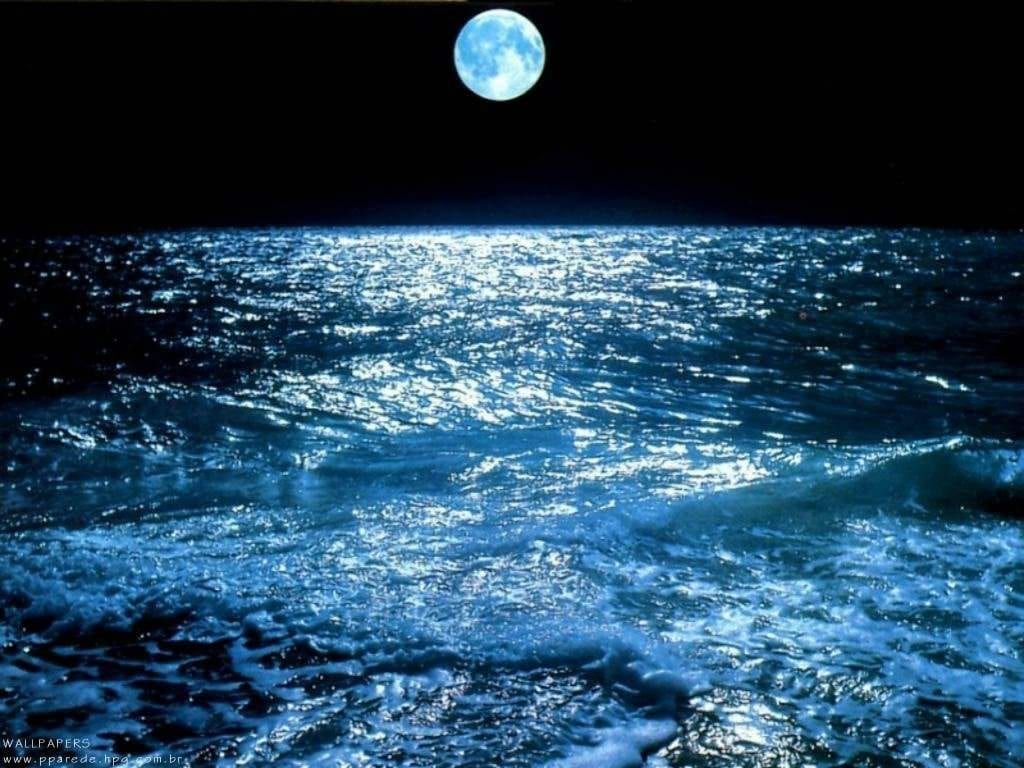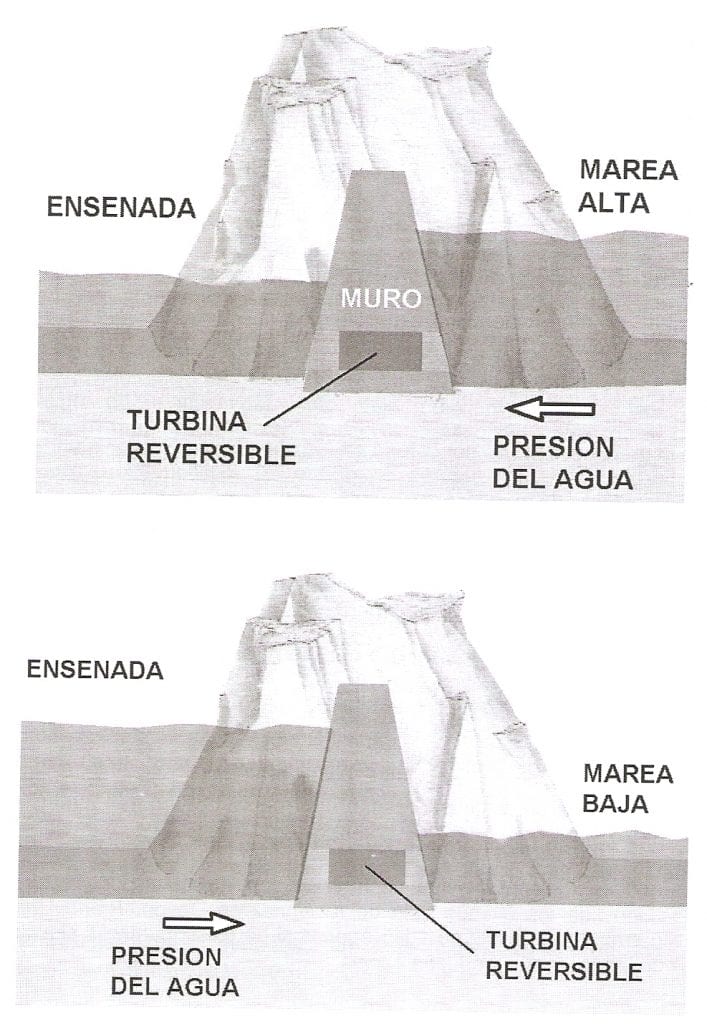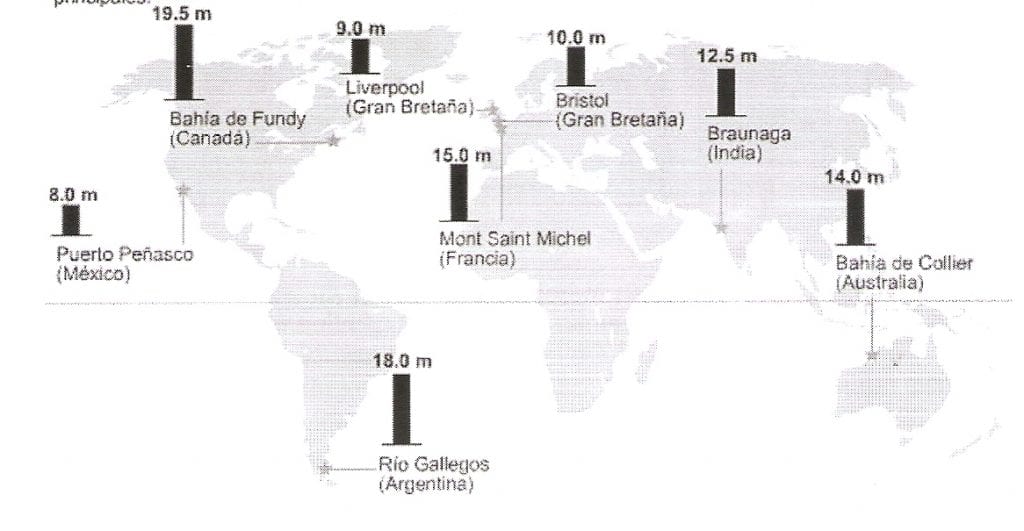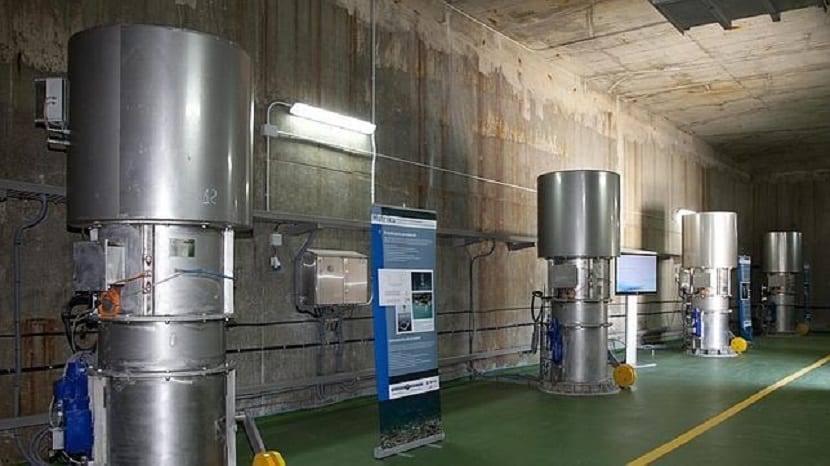
The energy of the tides or more scientifically known as tidal energy is the one that results from harnessing the tides, that is, the difference in the average height of the seas according to the relative position of the Earth and the Moon and that results from the gravitational attraction of the latter and the Sun on the water masses of the seas.
With this term we can say that the movement of the waters, produced by the attraction of the Moon twice a day, it is possible to use it as an energy source.
This movement consists of a rise in sea level, which in some areas can be considerable.
The Moon is losing energy, very slowly, and is generating tidal forces, which in turn causes it to be located at a greater and greater difference from the earth.
The average dissipation of energy in the form of tidal forces is about 3,1012 watts, or about 100.000 times less than the average sunlight received on earth.
Tidal forces not only influence the oceans, creating ocean tides, but they also affect living organisms, generating complex biological phenomena that constitute part of the natural biorhythms.
The tide produced by the Moon in the oceans is less than one meter high, but in those places where the configuration of the terrain amplifies the effect of the tide, a change of much greater level can occur.
This occurs in a small number of shallow areas, located on the continental shelf and it is these areas that can be used by man to obtain energy through tidal energy.
Use of tidal energy
Contrary to what one might think of tidal energy, it has been used since long ago, in ancient Egypt it was used and in Europe it began to be used in the XNUMXth century.
In 1580, 4 reversible hydraulic wheels were installed under the arches of London Bridge to pump water., which continued in operation until 1824, and until the Second World War, a multitude of mills were operating in Europe, which used the force of the tides.
One of the last stopped operating in Devon, UK, in 1956.
However, since 1945 there has been little interest in small-scale tidal power.
Use of tidal energy
The use of tidal energy in principle is simple and is very similar to that of hydroelectric power.
Although there are various procedures, the simplest consists of a dam, with gates and hydraulic turbines, located closing an estuary (mouth, in the sea, of a wide and deep river, and exchanges with this salt water and fresh water, due to the tides. The mouth of the estuary is formed by a single wide arm in the shape of a widened funnel), where the tides have a certain height importance.
To analyze the work of the system can be seen in the following two images.

The operation is very simple and consists of:
- When the tide rises it is said that the high tide (highest state or maximum height reached by the tide), at this time the gates are opened and the water begins to turbine that accesses the estuary.
- When the high tide passes and a sufficient water charge has built up, the gates close to prevent the water from returning to the sea.
- Finally, when the low tide (lowest state or minimum height reached by the tide), the water is let out through the turbines.
The entire process of entering the water into the estuary as well as the exit, the turbines drive generators that produce electrical energy.
The turbines used must therefore be reversible so that they work correctly both when water enters the estuary or inlet as well as when leaving.
Distribution of the tides in the world
As I have previously commented the tides are amplified by the configuration of the seabed in some specific areas, where it would be possible to use the tides as a source of energy, which is ultimately what interests us.
The most prominent places to do this are:
- In Europe, in the bay of La Ranee in France, in Kislaya Guba in Russia, in the Severn estuary in the United Kingdom. All these sites have extremely high tides, with a daily rise and fall of 11 to 16 meters.
- If we go to South America we see that there are tides of more than 4 meters along the coasts of Chile and the southern region of Argentina. The tide reaches 14 meters in Puerto Gallegos (Argentina). There are also suitable sites near Belern and Sao Luiz, Brazil.
- In North America, in Baja California, in Mexico, with tides of up to 10 meters, it has been mentioned as a possible region for the use of tidal energy. In addition, in Canada, in the Bay of Fundy, there are tides of more than 11 meters as well.
- In Asia, high tides have been recorded in the Arabian Sea, the Bay of Bengal, the South China Sea, along the coast of Korea and in the Sea of Okhotsk.
- However in Rangoon, Burma, the tides reach heights of 5,8 meters. At Amoy (Szeming, China), 4,72 meter tides occur. The height of the tides in Jinsen, Korea, exceeds 8,77 meters and in Bombay, India, the tides reach 3,65 meters.
- In Australia, the tidal range is 5,18 meters at Port Hedland and 5,12 meters at Port Darwin.
- Finally, in Africa there are no favorable locations, perhaps modest power plants could be built south of Dakar, in Madagascar and in the Comoro Islands.
Worldwide, there are about 100 suitable sites for project construction large, although there are many others where smaller projects could be built.
They could even be used, for the generation of electricity, tides below 3 meters, although its profitability would be much lower.
However, the installation of a tidal power station (to be effective) is only possible in places with a difference of at least 5 meters between high and low tides.
There are few points on the globe where this phenomenon occurs. These are the main ones:

In total, it could be installed for the production of electricity, in the main sites of the world about 13.000 MW, figure equivalent to 1% of the world's hydroelectric potential.
Tidal energy in Spain
In Spain the study of this energy is carried out especially by the Institute of Hydraulics of the University of Cantabria, which has a fairly large test tank for research and experimentation of what is known as Cantabrian Coastal and Ocean Basin (marine engineering).
The aforementioned tank is about 44 meters wide and 30 meters long, thus being able to simulate waves of up to 20 meters and winds of 150 km / h.
On the other hand, we are not left behind, since in 2011 the first tidal plant located in Motrico (Guipuzkoa).

The control unit has 16 turbines capable of producing 600.000 kWh per year, that is to say, what 600 people consume on average.
In addition, thanks to this central hundreds of tons of CO2 will not go into the atmosphere each year, it is estimated that it has the same purifying effect that could cause a forest of about 80 hectares.
This project had a total investment of about 6,7 million euros of which about 2,3 were for the plant and the remainder for the work on the dock.
The turbines, which each generate about 18,5 KWh, are divided into groups of 4 and are located in the machine room, at the top of the jetty.
In addition, the area that shelters them is located in one of the central curved sections of the dike with an average water height of 7 meters and about 100 meters in length.
Advantages and disadvantages of tidal energy
Tidal energy has many and advantages and some of them are:
- It is an inexhaustible source of energy and renewable.
- This distributed over large areas the planet.
- It's perfectly regularregardless of the time of year.
However, this type of energy presents a series of serious drawbacks:
- The considerable size and cost consequent on its facilities.
- The need for sites have a topography that allows the construction of the dam relatively easily and inexpensively.
- La intermittent production, albeit predictable, of energy.
- The possible harmful effects on the environment such as landings, reduction of estuarine beaches, on which many birds and marine organisms depend, reduction of breeding areas for marine species and accumulation of polluting residues in estuaries contributed by rivers .
- Restriction of access to ports located upstream.
The drawbacks of this type of energy make its use very controversial, so its implementation is probably not convenient except in very specific cases, in which it is found that its impacts are very small compared to its benefits.
Many years ago I managed to yell "Eureka!" (Archimedes) when with my home experiments I achieve the very simple EOTRAC mechanism, which only takes advantage of the superior force of the wind, the great volume of this infinite force, which is limited only to the resistance of the materials. Then I achieved the very simple mechanism of the GEM that allows to use separately the infinite force of the flow that operates upper blades (blades) of hundreds or thousands of square meters and a similar function fulfills the ebb tide, and so on again - and more loud - I shouted "Eureka !, Eureka!", for this small grain of sand to produce clean energy, unfortunately the powerful of Global warming are silent or consider me a "nut". SEE rebich-inventions on cell phone
I am a simple retiree born in 1938, NOBODY GIVES ME A BALL, I need all together to see, understand and debate how the force of nature itself can produce clean energy to reduce GHG and prevent global warming (universal fire) destroy more and more the possibility of human life on earth.